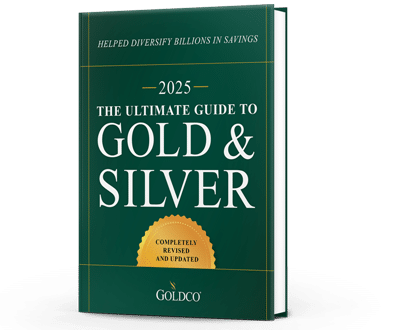This Is How a Gold IRA Works
With everything that’s going on in the world today, more and more people seem to be getting nervous about their future’s well-being Stock markets are starting to worry about the threats of a...
Precious Metals

When assessing the performance of retirement assets, or indeed of any investment, most people look at the total return of an investment when assessing how much asset growth they’ll see. But looking just at nominal numbers doesn’t tell the whole story. You have to know how much your assets are growing after inflation. After all, if you’re gaining 2% but inflation is at 5%, you’re actually losing 3% per year. Similarly, if you’re gaining 8% but inflation is at 5%, then you’re only gaining 3%, or less than half what you think you’re gaining.
Especially when it comes to retirement, knowing what your real returns are can be an important part of assessing the overall financial performance of your investment portfolio. And while looking at overall returns is certainly important, knowing the return after inflation is just as important. With that in mind, let’s look at a few common sources of retirement income assets to see just how they perform versus inflation.
Despite the fact that people are hounded almost from the time they start working to start saving money in a retirement account, millions of people still think they’re going to be able to rely on cash as a retirement asset. Whether it’s money stuffed under the mattress, held in a savings or checking account in a bank, or invested in a money market account, Americans hold trillions of dollars in cash.
In recent years, interest rates on savings accounts have been minimal. Thanks to the Federal Reserve’s zero interest rate policy, banks have offered interest rates just barely above zero. Many older Americans may remember the days when bank savings accounts offered 2-4% interest or more. They felt like putting money in the bank was actually working for them. But in reality, putting money in a savings account has always been a losing proposition, as bank savings accounts have always earned less than inflation over the long term.
In the US, the annualized inflation rate since President Nixon closed the gold window in 1971 has been 3.85%. That’s according to the government’s own CPI data, which many people feel actually understates the true rate of price increases. But unless your bank account was averaging more than that amount over the long term, you were losing real purchasing power. And today, with inflation around 2% and bank accounts offering near zero, putting money in the bank is a guaranteed money loser.
Millions of Americans rely on Social Security for their retirement income. Whether it’s just a piece of supplemental income for them, or whether it’s their main source of retirement income, over the several decades of the program’s existence it has come to be a major pillar of retirement planning. But the trust that many retirees place in the system is misplaced.
The financial problems with Social Security are many, and have been written about extensively in the past. Without a major fix, the Social Security trust fund will run out of money no later than the mid-2030s. At that time, Social Security tax receipts will only be sufficient to pay out about 75% of expected Social Security benefits. So retirees expecting to rely on Social Security will be sorely disappointed.
Even were Social Security to be in great financial shape, the benefits aren’t growing like they need to be. The cost of living adjustment (COLA) for Social Security this year was only 1.6% and, given CPI data so far this year, the COLA for 2021 could be zero. There have been numerous years recently when Social Security COLAs were zero or near-zero, with the COLA averaging 1.4% over the past decade. In fact, since 2000, COLAs have increased a total of 53%, while the prices paid by seniors have increased by nearly 100%.
Seniors often experience higher rises in the cost of living, thanks in part to rising healthcare costs. That means that their cost of living increases even faster than the CPI. So even with the COLA matching the CPI, it’s not helping seniors being able to buy what they need to.
Stocks have been one of the most popular investment choices for decades. That’s in part due to incessant financial media discussion of how stocks are the best way to grow assets over the long term. The total real return for stock markets over the long term has normally been around 7%. That’s the return after inflation, which is a pretty good return. But with poor stock market performance over the past two decades, those numbers don’t reflect the current reality of stock market performance.
Looking back over the past roughly 50 years, since the closing of the gold window in 1971, the annualized returns of stock market indices have been 7.14% for the S&P 500 and 6.95% for the Dow Jones Industrial Average. Those are returns before inflation. Take out that 3.85% for inflation and you get 3.29% for the S&P and 3.10% for the Dow. That’s still not a bad real return, but it’s not nearly as high as many investors would like to see.
Finally, gold is an investment asset that many investors turn to in times of economic turmoil and financial turbulence. It’s often touted as an asset for investors to hold as a hedge against inflation, stock market crashes, and financial crisis. But an underappreciated aspect of gold is that it performs well over the long term in both good times and bad.
Looking again at the period after the gold window closed in 1971, gold’s annualized returns have been 7.93%. Adjusted for inflation, that’s a real return of 4.08%, or 24% greater than the S&P 500 and 32% greater than the Dow. That’s not too bad for an asset that’s often ignored by many mainstream investment advisers. And with a gold IRA, you can even roll over existing retirement assets from 401(k), 403(b), TSP, and IRA accounts into a gold IRA, allowing you to easily convert your current assets that may be heavily invested in stocks into a gold investment.
But regardless of what assets you decide to invest in, it’s important to remember that your overall return needs to beat inflation. Otherwise, you’re just allowing your assets to waste away. Don’t allow your purchasing power to lose out to inflation – make sure your assets are wisely invested today.

